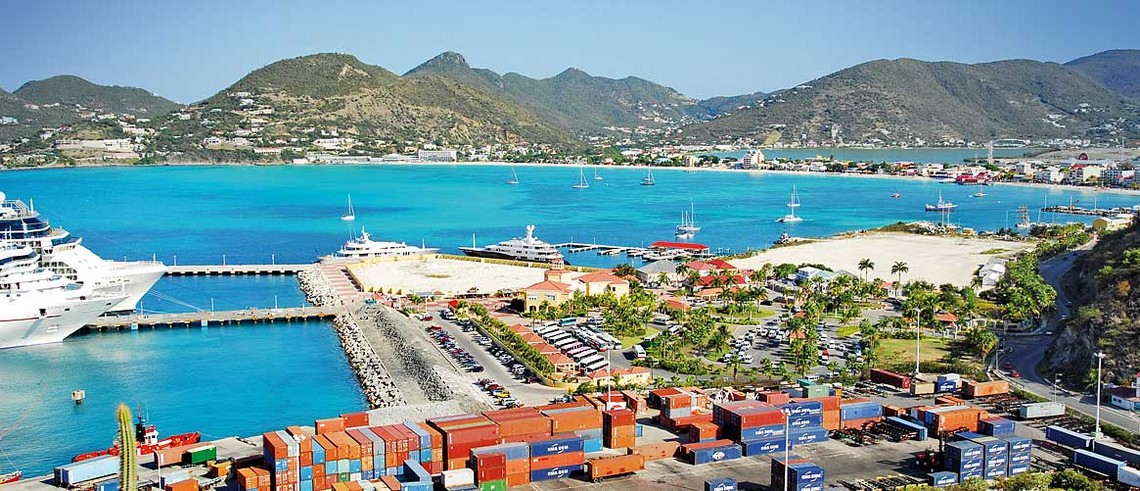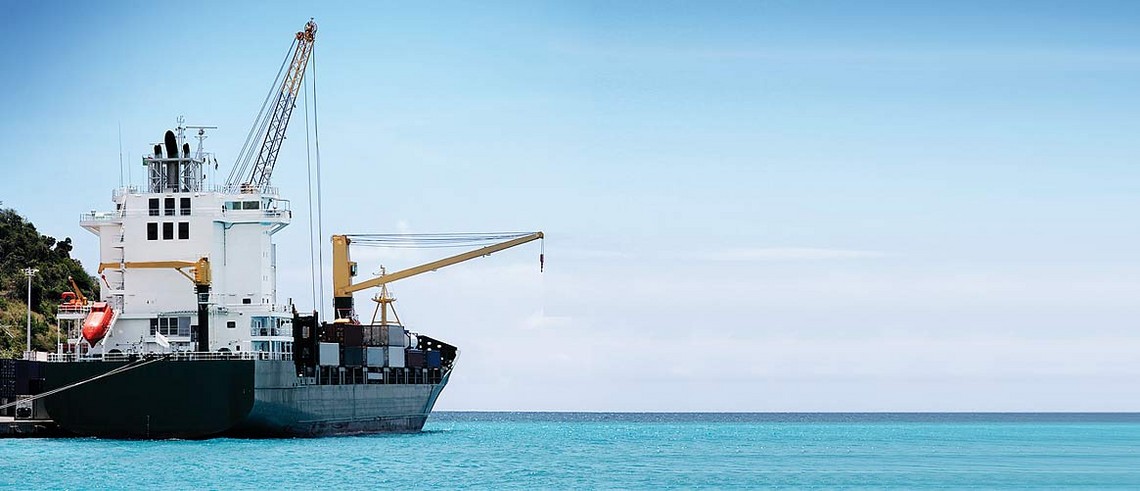Everything happens timely. In real-time. Saving time. The big picture. Any time. On time. At all times. Time is money. All harbor employee system-users are fully trained and certified by IT Partner BV. Higher employee efficiency = higher employee satisfaction. Closer cooperation between stevedores and port management allows for high customer satisfaction due to high productivity.
Accuracy and efficiency. Waste not want not. We do it faster. Our GSL software speeds up clearance from days to just minutes. Crane operations achieve rates of up to a max of 23 moves/hour (5 moves/hour more than average)! We do it better. Our port is your port. Our cargo sector and its transshipment future is bright. Our port facilitates growth for St. Maarten. Widespread optimism abounds.

PRODUCTIVITY
Effective and efficient cargo handling is a given at the Port St. Maarten’s Captain David Cargo Quay located at the Dr. A.C. Wathey Cruise & Cargo Facility. The terminal has grown symbiotically with its customers’ needs over the years and is now a regional sub-hub for container transshipment, serving both a wide range of international carriers as well as the all-important domestic market. The cargo sector is vital to the nation’s economy not only in terms of generated revenue but also because the majority of food and consumer goods needed by islanders are imported by sea. The streamlined and well-managed operation of which contributes considerably to the health and well-being of our people.
STATE-OF-THE-ART FACILITIES
Once 270 m and now 540, the Captain David Cargo Quay has an alongside depth of 10.5 m and now houses a 3,000 teu-container storage area. Container handling is facilitated by two Gottwald HMK 260E mobile harbor cranes, each with a lifting capacity of 100 tonnes. The port handles about 75,000 teu annually and also acts as a feeder port for many of the nearby smaller islands.
A breakwater at the southern end of the port protects the container yard from the worst of the storms and hurricanes that hit the island and, to further reduce wave impact, a westward extension is planned. Alongside a 444 m2 warehouse there is an inter-island pier serving the local region and there are two ro-ro berths at the southern and northern ends. St. Maarten serves as a transshipment hub for the islands of Anguilla, Montserat, St. Barths, St. Kitts & Nevis, and Antigua and Barbuda.
TRANSSHIPMENT On the rise again and forecasted to dominate cargo growth, the main focus of the Harbor Group is the development of the transshipment sector. We’ve established ourselves as a competitive option as well as an efficient choice for shippers. We operate 24/7. We have easy deepwater access to berths. We’ve invested in new infrastructure, equipment and in the GLS software platform. Our crane operations have been streamlined.
New lines are realizing these benefits of transshipping via St. Maarten. Increased construction on our island and on neighboring ones means more project cargo will be shipped through St. Maarten. Feeder ports such as St. Maarten will play a greater role as the shipping sector continues to grow. Major shipping lines have moved to St. Maarten. When this took place, we were already ready. The depth alongside the cargo quay can be increased to 12.0 meters. We’ve done our homework!
SECURITY
Software plays a vital role in port security procedures. Monitoring of gate activities as well as monitoring of vessel and personnel movements within the port is vital. We are watching. An electronic access card system has been implemented for all port staff, operators and customers. Future integration with the HR department is also under consideration.

SERVICES
In order to allow for greater commercial flexibility and to maintain a competitive edge, Port St. Maarten became a landlord port in 2001. St. Maarten Shipping & Stevedoring NV (SSS) and St. Maarten Port Services now carry out our cargo handling operations.
The equipment range available at the quay includes reach stackers, top lifters, yard mules, chassis, fork-lifts and much more. Island-wide transportation services are readily accessible using a large fleet of chassis and trucks. Container repair, warehousing and logistics services are also supplied. Our range of services has grown in conjunction with volumes handled to meet customer needs. We’re flexible and willing to expand with our clients. Symbiosis. We fulfill a vital role as the first port of call for inbound cargo ships arriving from Europe destined for other neighboring islands. We’re here to meet needs of the lines that call. Fresh water provision, bunkering and garbage removal, waste oil and glass recycling needs can be met.
PRODUCTIVITY THROUGH THE GLOBAL LOGISTIC SYSTEM.
Our port has been fully automated since we introduced the GLS software. In partnership with Dutch companies IT Partner BV and Dalosy Industrial Systems(DIS), The Global Logistic System (GLS) software was implemented at the port in 2009 using a modified version of the company’s standard software package.
A computer system customized for us by adding cruise, marina and port management modules and including bridge opening and fuel supply components. GLS is used for vessel planning, container, general cargo and ro-ro operations, dock master/berth planning, cruise and marina services as well as for billing and invoicing.
DIGITALIZATION OF LOGISTICS
Besides repairing hurricane related damages, and seeing double-digit growth, Port St. Maarten is also creating a more data centric environment. Data traffic is playing an increasingly bigger role. To remain relevant and to be able to continue to improve upon our operational excellence and to remain a competitive and successful logistical hub, investments are also needed in this area.
Ports use to be all about goods, ships, and cargo traffic, and today more focus in being played on better data management for better insight and decisive decision making with the sharing of details among its key stakeholders to maintain its competitive edges within the market.
Digitalization of logistics is the future. Technology will radically change the way logistics are organized. As logistics become more complex, there is an increasing need to digitalize information streams. It will allow for optimization of current existing infrastructure, reducing the need to invest in additional infrastructure.
Port St. Maarten has been actively exploring big data usage by having discussions with Portbase Rotterdam and IT Partner about a national port community system that involves data-sharing.
The overall objective is to have a complete information technology system in place at the port that allows stakeholders to access real-time information about container movements as well as contents thereby improving efficiency.
The Port Community System (PCS) involves data-sharing among stakeholders and third parties covering cargo and cruise operations at the country’s seaport of entry.
PCS is an extension of Port St. Maarten’s Terminal Operating System that would further enhance the port’s operational excellence platform linking for example cargo/container manifest to an incoming/outgoing vessel to warehouse/storage handling and receiver pick-up.
Stakeholders and prospective main holders of the system are very impressed and excited with the port in creating a single window platform for big data centralization that would further increase overall efficiency in port operations.
The PCS will allow all key parties such as agents to be connected to a secure cloud-based approach system which will enhance information sharing with the primary focus being on sustainable business development for the St. Maarten port community along with information data centric sharing with Customs, Coast Guard, Maritime Affairs, Immigration & Border Protection, Public Health and possibly other Government entities.
Today, effective and efficient cargo handling is a given at Port St. Maarten’s Captain David Cargo Quay located at the Dr. A.C. Wathey Cruise & Cargo Facility serving customers on St. Maarten/St. Martin and the neighbouring islands.